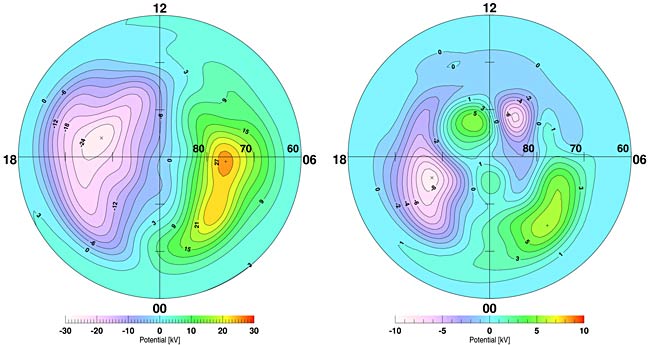Near-Earth Space Bubbles Mapped

Enormousbubbles of plasma trapped within Earth?s magnetic fields have been fully mappedfor the first time.
Scientistsnow think the bubbles of ionized gas, called convection cells, are stronglyaffected by pummeling from the sun's solar wind. Future observations of thecells could be used to monitor violent solar outbursts, such as solar flaresand coronal mass ejections, which can harm satellites or astronauts in space.
?Theresults are a great achievement," said Philippe Escoubet, the European SpaceAgency (ESA) project scientist for the experiments aboard the Cluster satellites.
SteinHaaland, a scientist at the Max Planck Institute in Germany,and his team used six years of data gathered by the four spacecraft tocreate the maps. "They show data collected over years is helping deepenour understanding of the Sun-Earth connection,? Escoubet said.
Convectioncells exist high above Earth's polar caps and are made of plasma, which iselectron-stripped gas that is highly erratic. Earth's magnetosphere andatmosphere shelter the planet from high-energy solar particles, but theprotective shells form an incomplete cocoon—so some of the radiation leaks in,is trapped and forms convection cells.
Scientiststhink understanding how such particles are trapped is crucial to safeguardingastronauts and satellites, such as GPS and telecommunications platforms.
Prior to theCluster satellites, only poor observations of convection cellscould be made. The new statistical maps show that numbers of convection cellsfluctuate between two and four, and that their shapes change as solar windoutput fluctuates.
Get the Space.com Newsletter
Breaking space news, the latest updates on rocket launches, skywatching events and more!
Haaland said the maps willinform future monitoring of convection cells. "It will be possible to mapthe region at any altitude, under any conditions with satellites, making ourtask easier," he said.
Haaland and his colleagues' work is detailed in recent issues of the journal AnnalesGeophysicae.
- VIDEO: Sun Storms
- GALLERY: Hyperactive Sun
- Top 10 Images of the Sun
Join our Space Forums to keep talking space on the latest missions, night sky and more! And if you have a news tip, correction or comment, let us know at: community@space.com.
Dave Mosher is currently a public relations executive at AST SpaceMobile, which aims to bring mobile broadband internet access to the half of humanity that currently lacks it. Before joining AST SpaceMobile, he was a senior correspondent at Insider and the online director at Popular Science. He has written for several news outlets in addition to Live Science and Space.com, including: Wired.com, National Geographic News, Scientific American, Simons Foundation and Discover Magazine.









